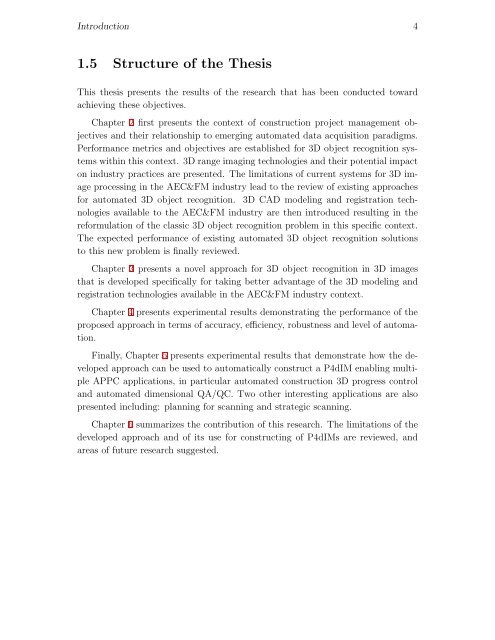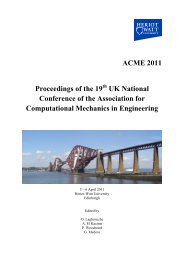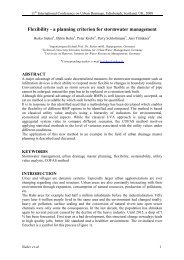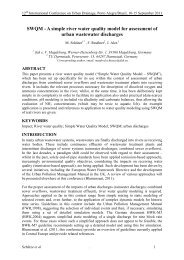PhD Thesis - Automated Recognition of 3D CAD Model Objects in ...
PhD Thesis - Automated Recognition of 3D CAD Model Objects in ...
PhD Thesis - Automated Recognition of 3D CAD Model Objects in ...
You also want an ePaper? Increase the reach of your titles
YUMPU automatically turns print PDFs into web optimized ePapers that Google loves.
Introduction 4<br />
1.5 Structure <strong>of</strong> the <strong>Thesis</strong><br />
This thesis presents the results <strong>of</strong> the research that has been conducted toward<br />
achiev<strong>in</strong>g these objectives.<br />
Chapter 2 first presents the context <strong>of</strong> construction project management objectives<br />
and their relationship to emerg<strong>in</strong>g automated data acquisition paradigms.<br />
Performance metrics and objectives are established for <strong>3D</strong> object recognition systems<br />
with<strong>in</strong> this context. <strong>3D</strong> range imag<strong>in</strong>g technologies and their potential impact<br />
on <strong>in</strong>dustry practices are presented. The limitations <strong>of</strong> current systems for <strong>3D</strong> image<br />
process<strong>in</strong>g <strong>in</strong> the AEC&FM <strong>in</strong>dustry lead to the review <strong>of</strong> exist<strong>in</strong>g approaches<br />
for automated <strong>3D</strong> object recognition. <strong>3D</strong> <strong>CAD</strong> model<strong>in</strong>g and registration technologies<br />
available to the AEC&FM <strong>in</strong>dustry are then <strong>in</strong>troduced result<strong>in</strong>g <strong>in</strong> the<br />
reformulation <strong>of</strong> the classic <strong>3D</strong> object recognition problem <strong>in</strong> this specific context.<br />
The expected performance <strong>of</strong> exist<strong>in</strong>g automated <strong>3D</strong> object recognition solutions<br />
to this new problem is f<strong>in</strong>ally reviewed.<br />
Chapter 3 presents a novel approach for <strong>3D</strong> object recognition <strong>in</strong> <strong>3D</strong> images<br />
that is developed specifically for tak<strong>in</strong>g better advantage <strong>of</strong> the <strong>3D</strong> model<strong>in</strong>g and<br />
registration technologies available <strong>in</strong> the AEC&FM <strong>in</strong>dustry context.<br />
Chapter 4 presents experimental results demonstrat<strong>in</strong>g the performance <strong>of</strong> the<br />
proposed approach <strong>in</strong> terms <strong>of</strong> accuracy, efficiency, robustness and level <strong>of</strong> automation.<br />
F<strong>in</strong>ally, Chapter 5 presents experimental results that demonstrate how the developed<br />
approach can be used to automatically construct a P4dIM enabl<strong>in</strong>g multiple<br />
APPC applications, <strong>in</strong> particular automated construction <strong>3D</strong> progress control<br />
and automated dimensional QA/QC. Two other <strong>in</strong>terest<strong>in</strong>g applications are also<br />
presented <strong>in</strong>clud<strong>in</strong>g: plann<strong>in</strong>g for scann<strong>in</strong>g and strategic scann<strong>in</strong>g.<br />
Chapter 6 summarizes the contribution <strong>of</strong> this research. The limitations <strong>of</strong> the<br />
developed approach and <strong>of</strong> its use for construct<strong>in</strong>g <strong>of</strong> P4dIMs are reviewed, and<br />
areas <strong>of</strong> future research suggested.













